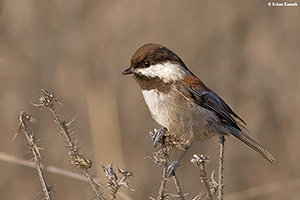 |
Chestnut-backed Chickadee
Parus rufescens |
|
|
STANFORD LOCATIONS: Common resident throughout campus, nesting in natural cavities and old woodpecker holes in a variety of trees and habitat types. Territories often adjoin those of the Oak Titmouse, with which the chickadee competes for nest sites and, to some extent, food -- though chickadees tend to forage more often on finer foliage than titmice, which forage more frequently on branches. Heads often look blackish. |
 |
Location |
Type |
Mating System |
Parental Care |
2ndary Diet |
Strategy |
|
|
|
|
I: ? DAYS ALTRICIAL |
|
|
|
1.5 feet - 12 feet (To 80 feet) |
|
(5-9) MONOG |
? |
FRUIT |
|
| BREEDING: | Conif and mixed conif-decid forest, primarily in humid regions. ? broods. |
| DISPLAYS: | ? |
| NEST: | In natural or excavated cavity; lined with moss, fur, plant down, feathers. |
| EGGS: | White, sparsely marked with reddish-browns. 0.6" (16 mm). |
| DIET: | Includes spiders and their eggs; seeds include mostly conif. |
| CONSERVATION: | Winter resident. |
| NOTES: | Bird on nest hisses and flutters wings in response to disturbance. May compete for food resources with ecologically similar Hutton's Vireo where both are resident. In winter, form mixed-species flocks with other chickadees, kinglets, nuthatches, warblers, bushtits, Brown Creepers, and juncos. |
| ESSAYS: | Bird Guilds; Bathing and Dusting; Mixed Species Flocking. |
| REFERENCES: | Hertz et al., 1976; Wagner, 1981. |
| Help | Abbreviations | Species-Alphabetical | Species-Taxonomic | Essays-Alphabetical | |
| Except for Stanford Locations, the material in this species treatment is taken, with permission, from The Birder's Handbook (Paul Ehrlich, David Dobkin, & Darryl Wheye, Simon & Schuster, NY. 1988). | |||||